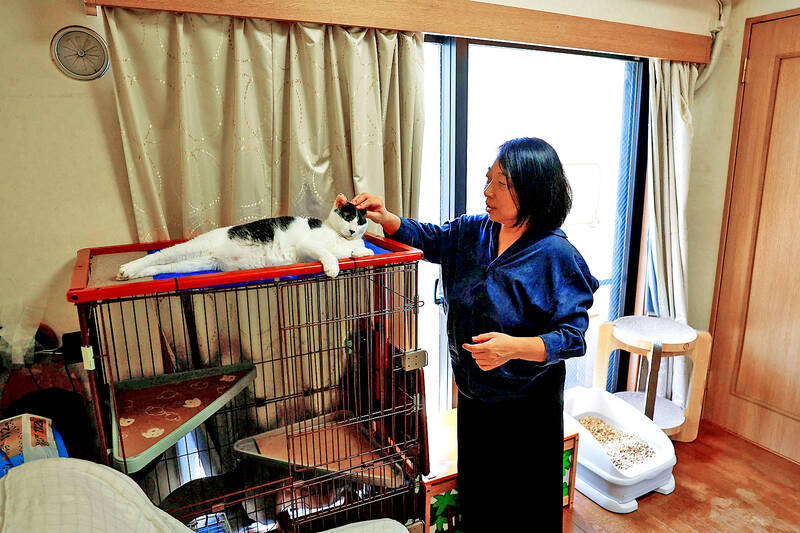Mayumi Kitakata frets about the health and well-being of Chi, her stoic housemate who enjoys treats, indulges a bit too much in the catnip and at about 14 is getting on in years for a feline.
Kitakata, 57, has had pet cats come and go over the years and to help give Chi as many seasons as possible, she has turned to artificial intelligence (AI).
In March, Kitakata became an early adopter of CatsMe!, an AI-driven smartphone application that purports to tell when a cat is feeling pain. That cuts down on the guesswork of when it is necessary to embark on a stressful trip to the veterinarian.

Photo: Reuters
“He is at an age where more and more diseases are going to appear,” Kitakata said. “So being able to consult the vet, but still reduce the number of visits to the hospital is very important for him and for me.”
The Japan Pet Food Association estimated there were almost 16 million pet cats and dogs in Japan last year, more than the number of children under 15.
Tech start-up Carelogy and researchers at Nihon University developed CatsMe! by training it on 6,000 pictures of cats. The app has been used by more than 230,000 people since its launch last year.
The developers say that it is more than 95 percent accurate and expect that degree to improve as the AI trains on more feline faces.
Nihon University professor Kazuya Edamura said that vets like him can tell to a certain degree whether an animal is in pain or not, but it is a harder task for owners.
“Our statistics show that more than 70 percent of elderly cats have arthritis or pain, but only 2 percent of them actually go to a hospital,” Edamura said. “So rather than a final diagnosis, we use [the app] as a tool to make owners aware of whether the situation is normal or not.”
Kitakata and Chi live in a central Tokyo apartment with the perfect feline napping spot near a balcony window that overlooks cherry trees five floors below. She monitors Chi’s toilet activity and uses the app to read its face each day.
Kitakata had cats since her mid-20s, including Soran, a brown-striped tom who died about six years ago from cancer at just eight years old.
“If I had noticed it, maybe we could have done cancer treatment earlier or something and it would have helped, but even the vet didn’t know,” she said, tears welling in her eyes. “I might have been able to save him.”

When Shanghai-based designer Guo Qingshan posted a vacation photo on Valentine’s Day and captioned it “Puppy Mountain,” it became a sensation in China and even created a tourist destination. Guo had gone on a hike while visiting his hometown of Yichang in central China’s Hubei Province late last month. When reviewing the photographs, he saw something he had not noticed before: A mountain shaped like a dog’s head rested on the ground next to the Yangtze River, its snout perched at the water’s edge. “It was so magical and cute. I was so excited and happy when I discovered it,” Guo said.

Chinese authorities said they began live-fire exercises in the Gulf of Tonkin on Monday, only days after Vietnam announced a new line marking what it considers its territory in the body of water between the nations. The Chinese Maritime Safety Administration said the exercises would be focused on the Beibu Gulf area, closer to the Chinese side of the Gulf of Tonkin, and would run until tomorrow evening. It gave no further details, but the drills follow an announcement last week by Vietnam establishing a baseline used to calculate the width of its territorial waters in the Gulf of Tonkin. State-run Vietnam News

Four decades after they were forced apart, US-raised Adamary Garcia and her birth mother on Saturday fell into each other’s arms at the airport in Santiago, Chile. Without speaking, they embraced tearfully: A rare reunification for one the thousands of Chileans taken from their mothers as babies and given up for adoption abroad. “The worst is over,” Edita Bizama, 64, said as she beheld her daughter for the first time since her birth 41 years ago. Garcia had flown to Santiago with four other women born in Chile and adopted in the US. Reports have estimated there were 20,000 such cases from 1950 to

DEFENSE UPHEAVAL: Trump was also to remove the first woman to lead a military service, as well as the judge advocates general for the army, navy and air force US President Donald Trump on Friday fired the chairman of the Joint Chiefs of Staff, Air Force General C.Q. Brown, and pushed out five other admirals and generals in an unprecedented shake-up of US military leadership. Trump wrote in a post on Truth Social that he would nominate former lieutenant general Dan “Razin” Caine to succeed Brown, breaking with tradition by pulling someone out of retirement for the first time to become the top military officer. The president would also replace the head of the US Navy, a position held by Admiral Lisa Franchetti, the first woman to lead a military service,